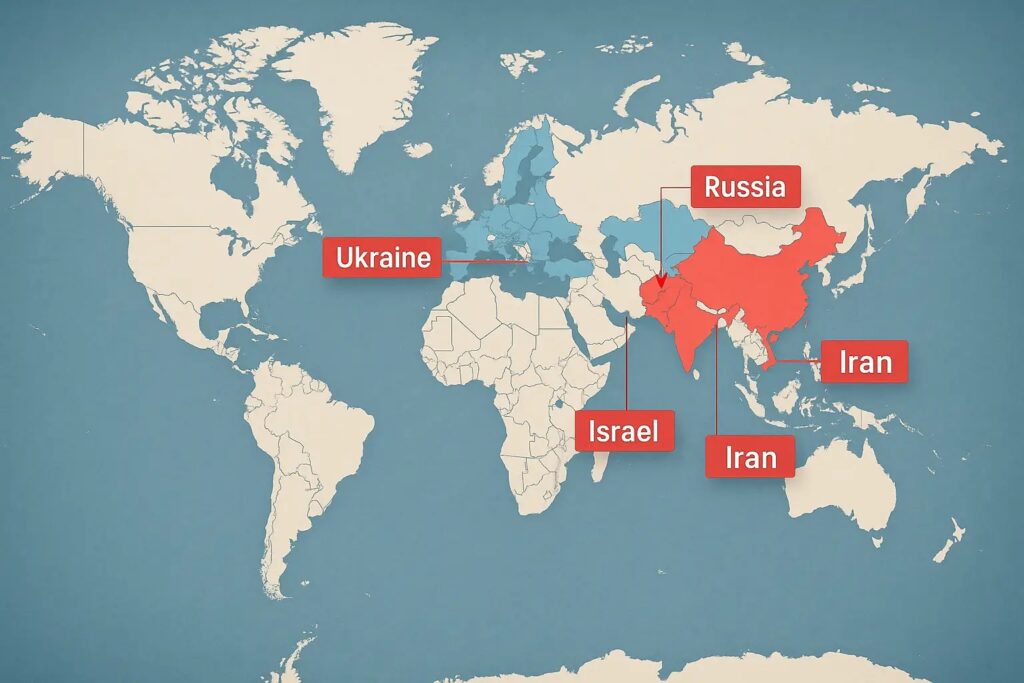Introduction: Countries Currently at War in 2025
War isn’t just about borders—it’s about people, upheaval, and lasting fallout. In 2025, several nations continue to grapple with conflict, each with its unique origins, human toll, and broader impact. This article paints a clear, realistic picture of those countries still at war—covering why, who is involved, and what it means for both civilians and the world at large.
1. Ukraine – Europe’s Ongoing Clash
- Conflict: Russo‑Ukrainian War
- 2024 Death Toll: ~49,881
- Overview: Since Russia’s full-scale invasion in 2022, Ukraine has faced persistent frontline battles, sieges, and devastating civilian losses.
- Human Angle: Communities torn apart, families displaced, and a society fending off winter offensives amid global geopolitical tension.
2. Israel–Palestine and Israel–Iran Escalation
Israel–Palestine Conflict
- 2024 Death Toll: ~22,386
- Overview: Longstanding hostilities between Israel and Palestinians in Gaza and the West Bank, continuing cycles of violence, ceasefires, and fragile calm.
Israel–Iran War (Launched June 2025)
- Status: Active air and missile strikes since June 13, 2025
- Highlights:
- Israel’s “Operation Rising Lion” targeted nuclear and military sites in Iran .
- Iran responded with ballistic missiles and drones, affecting Israel, Jordan, Syria, Iraq, and the West Bank .
- Human Toll: Hundreds killed, devastation across civilian areas, fears of regional escalation with global ripple effects .
3. Myanmar – Multi‑Front Civil War
- Conflict: Myanmar Civil War (since 2021)
- Situation: Following the 2021 coup, fighting has spread widely—central Myanmar, Shan, Rakhine, Kayah, and more.
- Human Story: Over 1.6 million displaced, towns like Lashio changing hands, civilians caught in shifting alliances.
4. Sudan – Civil War Devastation
- Conflict: Sudanese Civil War (2023–ongoing)
- Human Impact: Over 150,000 killed, 8.8 million internally displaced, 3.5 million refugees .
- Overview: Government forces vs. Rapid Support Forces and allied militias, widespread famine and urban warfare in Khartoum and beyond .
5. Somalia – Al‑Shabaab Offensive
- Conflict: Somali Civil War / 2025 Shabelle offensive
- 2025 Developments: Since February, al‑Shabaab launched Operation Ramadan, with hundreds killed, towns seized, and an attempted assassination on the Somali president.
- Impact: Civilian areas and military bases repeatedly hit, causing widespread insecurity.
6. Ethiopia (Amhara Region)
- Conflict: War in Amhara (continued violence since 2023)
- Insights: Federal forces clashing with Fano militia; thousands of civilian casualties; reports of abuses and detentions.
- Human Element: Communities living under de facto emergency, grappling with hunger, fear, and unreliable governance.
Other Noteworthy Conflicts
- North-East Nigeria & Burkina Faso: Persistent terrorist attacks, insurgencies resulting in thousands of deaths.
- Democratic Republic of the Congo: Rising conflict involving M23 rebels, regional spillover risks .
- Ethiopia’s Tigray Region: Ongoing low-level clashes even as focus shifts elsewhere.
Why These Wars Matter
Human Cost
Collectively, these conflicts have caused hundreds of thousands of civilian deaths, millions displaced, shattered economies, and long-term trauma.
Global Impact
- Disruption of global food and energy supplies (e.g., Sudan & Middle East).
- Refugee crises stretching borders and aid systems worldwide.
- Diplomatic and security challenges—from NATO involvement in Ukraine to Middle East flashpoints.
Hope Amid Crisis
- Ceasefire efforts, regional dialogues, and UN intervention offer glimmers of peace.
- Local NGOs and humanitarian missions risk everything to support communities in need.
Conclusion – A Call to Remember Humanity
In 2025, while the world races ahead with tech and policy, millions still live amid bombs, checkpoints, and fear. Awareness matters—these aren’t distant headlines but real lives at risk. Understanding each conflict’s root causes, progress, and especially the human element, brings us closer to advocating for peace, relief, and long-term stability.

